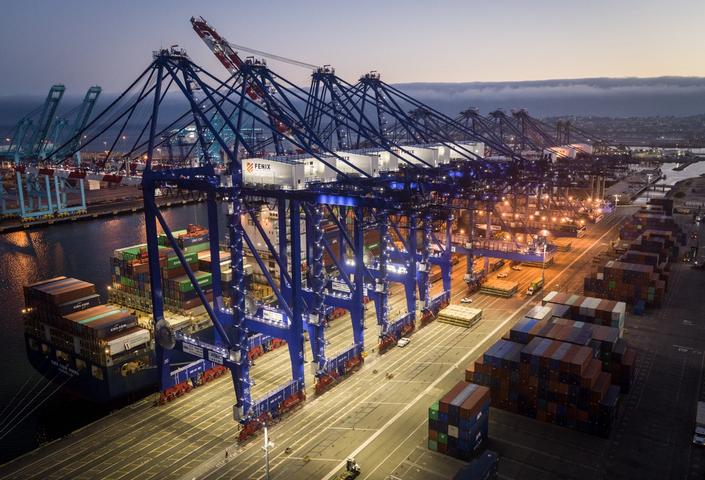Fenix Marine Services: at the forefront of e-commerce and transportation infrastructure
Fenix Marine Services (“FMS”) operates one of the largest container terminals in North America. When EQT Infrastructure invested in the company in late 2017, FMS began its transformation from a cost center into a market leader in the Port of Los Angeles. Since then, more than USD 100 million has been invested to upgrade terminal equipment and systems in order to expand capacity and improve productivity, efficiency and quality of service. These systematic upgrades enabled FMS to excel amidst an environment of rapid change during the COVID-19 pandemic, future-proofing the company for the long-term.

To facilitate FMS’ transformation, EQT brought in a new and highly experienced management team led by seasoned port infrastructure Chief Executive Officer, Sean Pierce. Under new management, FMS invested in significant new yard equipment, larger cranes, and new operating technology, including all new IT systems, and took significant steps to improve sustainability.
Over the past few years, the management team has been focused on implementing an internally developed, first of its kind, artificial intelligence platform. Hyper Optimized Nodal Efficiency (HONE), which was completed in 2020, is a proprietary technology that uses machine learning to optimize terminal operations.
The first phase of HONE optimized scheduling for truckers picking up containers by setting appointment windows when terminal equipment was near those containers. To make operations even more efficient, FMS launched an automatic “push” appointment system for truckers that incentivizes them to choose the optimal pickup times. This has reduced both yard congestion and truck turn times and helped to further improve FMS’ reputation among truckers. HONE also enabled a suite of VIP Services to help customers precisely tailor the delivery of their cargo, saving time and money for all stakeholders.
“As a result of the capital investment and the new operating processes, culture and terminal layout, FMS has become one of the largest and most efficient terminals in North America. The benefits of these improvements became even more clear during the COVID-19 pandemic,” said Alex Darden, Partner and Head of US Infrastructure at EQT Partners.
The immediate impact of COVID-19 was a temporary shutdown of manufacturing in Asia, resulting in a reduction in container volumes along the TransPacific trade route. However, later in the year as lockdown restrictions began to lift in Asia, the US began to experience a fundamental shift in the consumption of consumer goods – a shift which FMS was uniquely prepared for. Consumers began to purchase more goods online than ever before. The e-commerce growth that was expected to occur over a ten-year period took place over just three months. This rapid growth created a need for a supply chain model with distribution centers closer to the end consumers, in contrast with central distribution models of the past. These factors drove a material rebound of import volumes in the second half of 2020. In fact, the Port of Los Angeles, where the FMS terminal is located, saw a 23 percent increase in inbound container volumes in December 2020 vs. December 2019.
Sean Pierce, CEO of FMS, commented, “Because FMS had efficiency measures already in place, we were nimble enough to scale operations down when imports fell and react in real time to keep up with increased demand just months later. Our machine learning and Artificial Intelligence, particularly the HONE initiative, enabled us to process inventory faster than most other terminals and move goods efficiently to help alleviate the congestion in Los Angeles Harbor.”
In the midst of these supply chain clogs was another important task – transporting the vaccine into the US when it became available. Because FMS was able to continue operations throughout the COVID-19 pandemic as a result of measures it quickly put in place to ensure employee safety and business continuity, the company was able to transport several containers of Moderna vaccine kits through the port in December. When the vessel carrying the vaccine kits arrived in the harbor, it was initially placed in the back of the queue of ships waiting to berth, but FMS was able to work with the Port of Los Angeles to immediately berth the ship and unload the containers carrying the vaccine for quick transport.
Looking ahead, import volumes are expected to remain strong in 2021 as the transition to e-commerce continues, and FMS remains uniquely positioned to deal with the continued influx of goods to West Coast ports. FMS is currently realizing the benefit of the investments in yard and gate improvements and expects to see further efficiency gains with future projects, including a second phase of the HONE initiative, which will aim to optimize vessel operations. FMS is also considering partnering with the Port of Los Angeles on an expansion, which would include berth extensions and new equipment. To this end, FMS remains uniquely positioned to become the single largest terminal in North America over time.